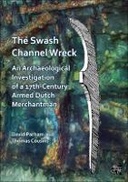Explore

The Swash Channel Wreck is an account of the discovery, excavation and analysis of an early 17th-century Dutch shipwreck. The wreck is most likely the Dutch West Indiaman Fame of Hoorn, lost in the Swash Channel in the approaches to Poole Harbour in February 1631. The site was initially found during dredging operations in the channel in 1990. In 2006, it was re-discovered by Wessex Archaeology, and Poole Harbour Commissioners partnered with Bournemouth University to undertake the monitoring and recording of the site. The remains are of a large c. 40m structure consisting of the port side of the ship from the turn of the bilge to the top of the upperworks, with associated wreckage which includes the ship’s rudder, a multitude of rigging items, and a small collection of finds that consist mainly of domestic and provisioning items and the ship’s armament.By 2009, it was clear that the site was rapidly eroding and English Heritage commissioned Bournemouth University to conduct one of the largest underwater excavations in the UK since the excavation of the Mary Rose in the 1980s. This occurred between 2010 and 2013 and involved the excavation and recording of the first 18m of the bow and the last 12m of the stern, leaving the 12m midship section unexcavated. In addition, a large section of the upperworks and the first 6m of the bow were deemed to be too exposed to protect in situ and therefore were raised and recorded in high detail between 2014 and 2015.The wreck proved to be the largest survival of the hull of any 17th-century ship in UK waters and one of the most complete 17th-century Dutch shipwrecks outside of the Baltic. The ship’s construction and material culture confirm its origin as a Dutch vessel lost in the early part of the 17th century. The hull has immediate parallels with the wreck of the Swedish warship Vasa, lost in Sweden in 1628, and the Dutch East Indiaman Batavia, lost in Western Australia in 1629, and exhibits characteristics of both. The circumstances of the Swash wreck provided the opportunity to dismantle the structure and study in greater detail the timbers from which it was constructed.Contemporary clearance work and probably salvage meant that with the site did not yield a large number of finds but those that remained provide an insight into life on board, the makeup of the crew, and the ship’s armament, as well as allowing the reconstruction of sections of the ship’s rigging.
This book is included in DOAB.
Why read this book? Have your say.
You must be logged in to comment.
Rights Information
Are you the author or publisher of this work? If so, you can claim it as yours by registering as an Unglue.it rights holder.Downloads
This work has been downloaded 3 times via unglue.it ebook links.
- 3 - pdf (CC BY-NC-ND) at OAPEN Library.
Keywords
- Archaeology
- History
- History: specific events & topics
- Humanities
- Maritime history
- Maritime History & Piracy
- Social Science
Editions

